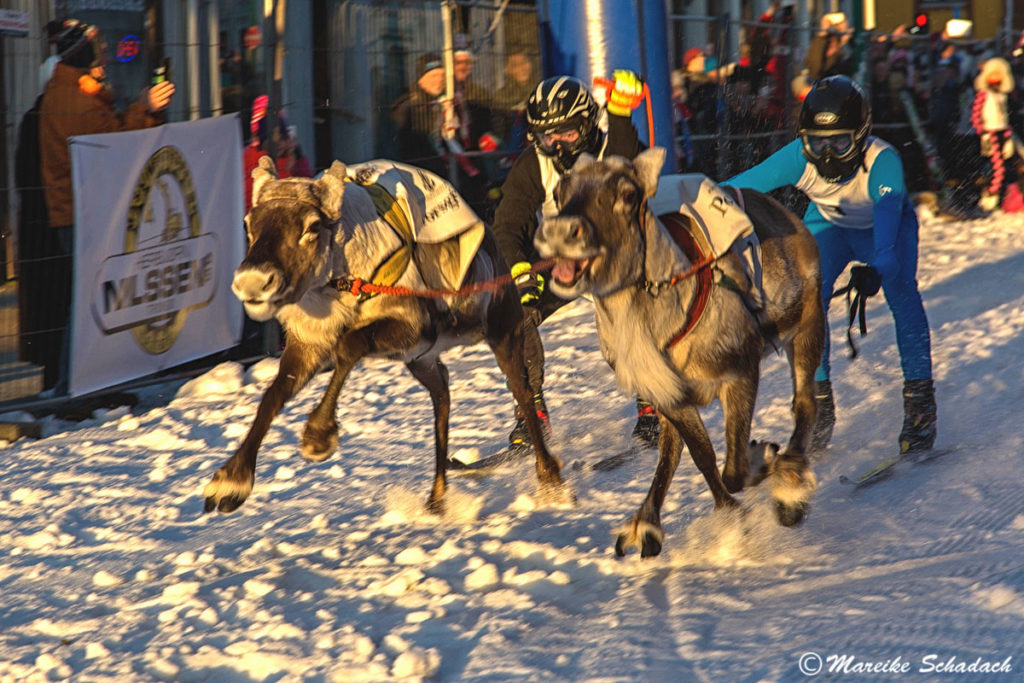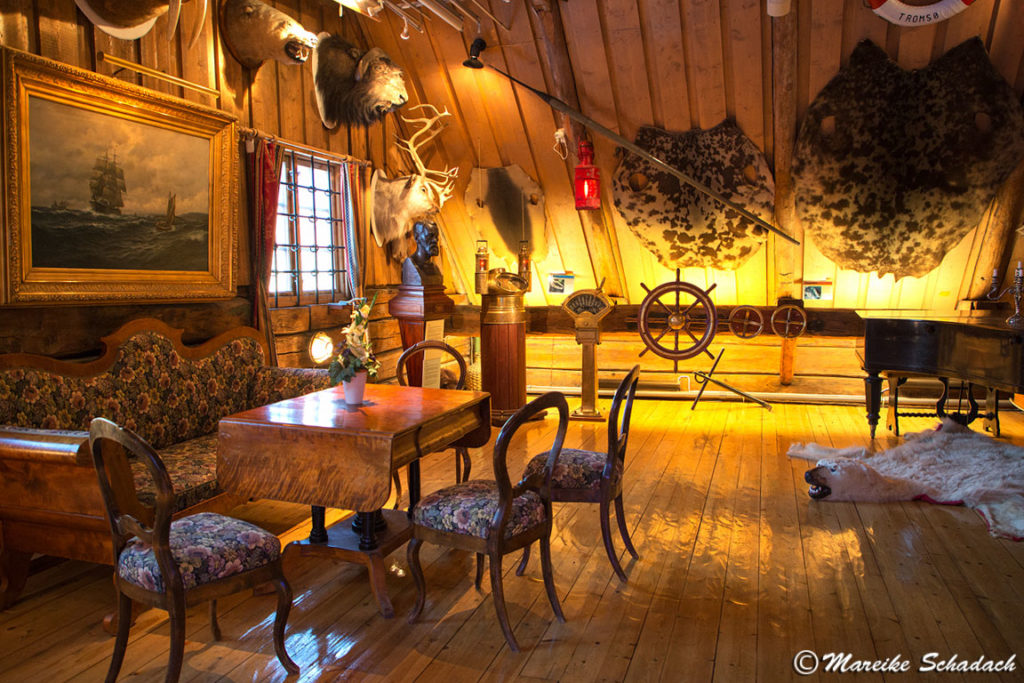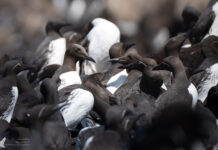Norway. A visit to Tromsø in winter quickly makes it clear why the city is called the gateway to the Arctic. The charming little harbour town makes one feel wanderlust when looking at the water. Many Norwegian expeditions to the Arctic have started from Tromsø. The Polar Museum at the harbour offers you more detailed insights into polar research. Do you feel like having some real Arctic experiences? Here you can find out why a trip to Tromsø in winter is absolutely worthwhile.
Unassigned, unpaid advertising. The article contains affiliate links.

What you will find in this article
Winter Boat Trip on the Fjords
See Northern Lights
Reindeer Race through Tromsø's Pedestrian Zone
Reindeer Sledge Ride under the Northern Lights
The "Gateway to the Arctic" - Polar History at the Polar Museum in Tromsø
Winter Boat Trip on the Fjords
When I planned our trip to Tromsø in winter, the boat trips were the first priority. As in the winter time, it is possible to see orcas in the fjords around Tromsø. The whales follow the migrations of the herring shoals. Between November and January they are then in the fjords near Tromsø and can often be seen close to land. But a little luck is always part of it. This is unfortunately the case with animal observations. When we were in Tromsø at the beginning of February, the whales had unfortunately already moved on.

We made the trip by boat anyway and did not regret it at all. The landscape is breathtakingly beautiful and we saw many sea eagles. Our trip over the fjords started in Lauklines. Here we were still provided with a thermal suit and warm boots, because on the boat it became bitterly cold after a while. As it should be for the Arctic.

If you want to try to see the orcas yourself, it is best to ask the organizer of the boat tours which months he would recommend. The routes of the herrings change over the years and so do the routes of the orcas. Read more in my article At the Orcas' Lunch Table - Snorkeling with Orcas In Skiervøy, Norway.

You are interested in whale-watching in winter? Then my article about Lofoten and Vesterålen might be something for you.
See Northern Lights
If you think of the Arctic in winter, you usually think of white snowy landscapes and northern lights. In green bands they move slowly across the sky and always amaze me. The mystical light plays in the night sky are simply beautiful. Sometimes there are even purple stripes at the edges.

Excursus: The Colours of the Northern Lights
Aurora Borealis is created when electrons from the solar wind meet gas molecules in the Earth's atmosphere. The molecules are electrically charged and excited to glow. Red, green or blue light is produced. There are also mixed colours such as violet, white and yellow. The colour depends on the height at which the electrons hit the atmosphere. Because the atmosphere has a different gas composition depending on the altitude. At an altitude of 80 to 150 kilometres, the oxygen content is higher and green light is produced. In contrast, at an altitude of 150 to 600 kilometres there are more nitrogen atoms and red and blue light is produced.
If you want to observe northern lights it is best to drive a little out of the city. Because the further away you are from the city, the less light pollution there is and the more intense the northern lights are visible. If you don't have your own vehicle, you can also join an organized aurora borealis tour.

In any case I can recommend a Prediction App. It informs you how high the probability for aurora borealis is at your location. The app uses the so-called KP-Index for this purpose. Furthermore the app offers you a forecast for the coming hours and days.
To take pictures of the aurora, you need a tripod and a fast lens. You should set the iso-value of your camera with open aperture so that the image noise does not affect the image quality. This varies from camera to camera.
Reindeer Race through Tromsø's Pedestrian Zone
Every year on a Sunday in February the pedestrian zone in Tromsø is transformed into a race track. In the middle of the Storgata, snow is piled up, at the northern end start boxes are set up and at the southern end the finish line is marked out.

I had no idea before how fast reindeer can run. They live up to their name. After the start signal they jump out of their pits and it goes in wild speed along the Storgata. They are driven by a slim rider who is pulled behind them on skis. Every year the 12 fastest races from Norway and Finland are at the start.

The race is the absolute highlight of the Sami week, which you must not miss. But the other events of the festival are also worthwhile and give you an insight into Sami culture. Sami (outdated Lapp) is the name of the indigenous population of the Arctic area of Sápmi. In honour of their culture, the Sami Week is celebrated in Tromsø every year at the beginning of February.

Throughout the week there is a varied cultural programme, including exhibitions, language courses, concerts and the Norwegian championship in lasso throwing. The Arctic market at the northern end of the Storgata offers traditional handicrafts and Sami food in lavvu (Sami tent). Here you can try bidos (reindeer meat stew) and lefse (soft flatbread made from potatoes) or try the super warm Sami woollen gloves.
Reindeer Sledge Ride under the Northern Lights
Enthusiastic about the fast reindeer that were racing in the Storgata, I booked a reindeer sleigh ride. At the tourist information at the Roald Amundsen Square there are offers for trips during daylight or in the evening with the chance of seeing northern lights. We started the same evening and after about an hour of driving we reached Camp Tamok.
It was -20°C. We were a bit away from Tromsø but I felt as if I had just walked through the gate to the Arctic. It was already dark and the sky was starry. After we were equipped with warm thermo suits and boots, we started. First we had to catch two reindeer. I had quite a lot of respect for the protruding antlers and hoped the animal would know how big it is. Not that it would run around me. But I didn't have to worry, because the animal stopped well-behaved and I was able to attach the rope to the halter. Proudly I led the reindeer to the sleigh. Each animal should pull one of the wooden sledges.

The Reindeer Sledge
The reindeer sleigh is a traditional means of transport for the Sami people. It was important in connection with nomadic reindeer husbandry, where shepherds followed the reindeer on their migrations. While reindeer were once used as draught or pack animals, nowadays tamed reindeer are used in sports or tourism.
Progress has been slow. But it was just the right speed to enjoy everything. Because above us the northern lights were moving in the starry sky. To the left and right of us were small snow-covered trees. The stars reflected in their icy branches and made them sparkle like Christmas trees. And in front of us the reindeer puffed, its breath condensed in the cold, dry air. A kitschy and beautiful experience!
To warm up, we had coffee and stories about life as reindeer herders in the traditional lavvu.

Reindeer Breeding
The beginnings of reindeer husbandry date back to the 15th century. In the 17th century, it became the livelihood of the mountain herders. Today, only a few Sami are still breeding. For economic reasons, however, it was intensified and the herds grew larger and larger. More than 500,000 reindeer live in the whole of Sápmi. The number of animals is now so high that their main food, lichen, can hardly grow back.
Mining, wind farms and conflicts with forest owners affect the reindeer economy. Climate change is also affecting the herds, as the animals no longer get enough food. Even under metres of snow the animals can track down lichens and mosses and dig them out with their hooves. However, when the snow becomes warm, too wet and then freezes again, a layer of ice forms which the reindeer cannot break through.
The "Gateway to the Arctic" - Polar History at the Polar Museum
The Polar Museum was opened in 1978 and is dedicated to hunting, fishing and research in the Arctic. Among other things, it reports on Norwegian polar expeditions and the history of the discovery of the North Pole. The museum building is located in a former customs building from 1833, which was used by customs as a warehouse and administration building until 1970. It is one of a series of pier houses that have been listed as historical monuments since 2000.

The exhibitions cover the following topics:
- Hibernation and hunting in the Arctic
- Hunter Henry Rudi, who killed 713 polar bears
- “Der” erste weibliche Überwinterer – Wanny Woldstad
- Fridtjof Nansens and Roald Amundsen's life and expeditions
- Helmer Hansen and Hjalmar Johansen, who accompanied Amundsen to the South Pole
- The discovery of Spitsbergen by Willhelm Barentsz in the 16th century, whaling in the 17th and 18th centuries and the Russian way of winter hunting
- Changing exhibitions under the roof of the warehouse
Thanks to its proximity to the Arctic, Tromsø has become the starting point for many polar expeditions. At the end of the 19th century, at the time of the great polar expeditions, Tromsø developed into the "Gateway to the Arctic". The Fram Expedition (1893 - 1896) of Fridtjof Nansen as also the expeditions of Roald Amundsen with the ship Maud (1918 - 1921) and with the flying boat Latham 47 (1928) are specially exciting.

Fram expedition of Fridtjof Nansen (1893 - 1896)
The Fram Expedition (1893 - 1896) of Fridtjof Nansen made a stopover in Tromsø. Via Vardø the Fram sailed along the Siberian coast to the New Siberian Islands. The aim of the journey was to reach the geographical North Pole by means of natural ice drift. For this purpose, the ice-strengthened ship was frozen in pack ice and drifted for about three years to Spitsbergen. In August 1896, the Fram returned to Tromsø. The ship did not reach the geographic North Pole. But Nansen and Johansen started the attempt to reach the geographic North Pole on foot. But after a march of approximately four weeks, they decided to turn back. They did not reach the geographical North Pole, but they set the North Record of that time. After spending the winter in the Franz-Josef Archipelago, they reached the port of Vardø in August 1896 on Frederik Jackson's ship Winward.

Maud expedition of Roald Amundsen (1918 - 1921)
On 16 June 1918 the ship Maud left Roald Amundsen in Tromsø and sailed northeast. The plan was to penetrate the ice in the eastern Arctic and drift with the ice to the North Pole for four or five years. However, the expedition did not go according to plan. After three overwinters in the ice and crossing the Northeast Passage, the Maud reached Seattle in 1921.
Rescue Mission of Roald Amundsen with the flying Boat (1928)
On June 18, 1928, Roald Amundsen set off with the flying boat of type Latham 47 to rescue Umberto Nobile. His airship Italia had previously crashed on an ice floe. Amundsen did not return from his search for Nobile. His flying boat was lost near the Bear Islands, the wreckage has not yet been found.
Book recommendations for Norway
You want to know where the journey goes? Then I can recommend these books*.
You can order the books with a click on the pictures on Amazon. If you buy a product via an affiliate link, I get a small commission, and you help me to keep filling Fernweh-Motive with interesting articles. The product will not be more expensive for you, and you will do me a huge favor.
Have you ever been to Norway in winter? Maybe even in Tromsø? Do you have any questions about my article? If so, please write me a comment!
Do you want to know when there are new articles on my blog? Then follow me on Facebook, Pinterest or Instagram. I would also be very happy if you share my article with your friends.















